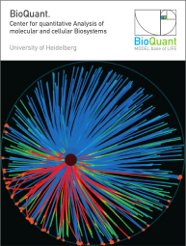Research Training Group: Mathematical Modeling for the Quantitative Biosciences (MMQB)
Understanding organ size control: Computational modeling of Hippo signaling and its cross-talk with other signaling pathways - BioQuant_Kummer0116 [position filled]
Supervisior: Prof. Dr. Ursula Kummer (BioQuant & COS)
Experimental partner: Prof. Dr. Kai Breuhahn (Medical Faculty)
Background and scientific question:
The Hippo pathway gained attention as a central cell density-dependent regulator of organogenesis and regenerative processes, especially in the liver. The pathway consists of the serine/threonine protein kinases Mst1/2 and Lats1/2 as well as adapter proteins (e.g., WW45/Sav1, Mob1, NF2). Its key downstream effector is the transcriptional co-activator Yes-associated protein (YAP). The relevance of the Hippo/YAP axis on organ size control is illustrated by the conditional knockdown of Hippo pathway components in the liver of mice (Mst1/2, NF2, WW45/Sav1) as well as YAP overexpression, which results in drastic liver overgrowth (+500%) and eventually tumor formation. The exact mechanism of organ size control however is not well understood and poses an interesting problem for a thorough experimental, as well as theoretical investigation. It is well accepted that the Hippo/YAP pathway also intensively crosstalks with other signaling cascades such as the WNT-, TGFa-, NF-kB, and PI3K/AKT pathways in different cell types. Remarkably, cell density and cowshed data). However, again, it is unclear how this is achieved by the interplay of the different pathways.
Project goal:
The goal of this project is to understand the dynamic interplay between the Hippo/YAP pathway and other important signaling pathways and to study, if cell polarity may affect the biological outcome of these interactions.
Planned work and collaboration within the RTG:
Quantitative experimental data is generated in the lab of Dr. Kai Breuhahn (Medical Faculty) and serves as a basis for a quantitative, detailed, mechanistic ODE model of the Hippo/YAP pathway and its interaction with other signaling pathways for some of which we already possess relevant computational models (e.g. TGFa- and NF-kB). Implementation is done in the software COPASI. Whenever necessary, stochastic models will be employed (overlap with U. Schwarz, I. Bischofs, T. Höfer and N. Grabe). The importance of the spatial distribution of players of the Hippo/YAP pathway for efficient information processing and organ size control is also studied. For the latter purpose a spatial model based on PDEs is implemented and analyzed. Here, we will heavily interact with the group of Anna Marciniak-Czochra. General questions concerning the of organ size control are investigated with smaller and more generic biochemical models. This will overlap with interests of the group of Thomas Höfer.
List of relevant publications:
1. Willems PH, Pahle J, Stalpers XL, Mugahid D, Nikolaew A, Koopman WJ, Kummer U (2015)
FEBS J. 282(11): 2187-201.
2. Veith N, Solheim M, van Grinsven KW, Olivier BG, Levering J, Grosseholz R, Hugenholtz J, Holo
H, Nes I, Teusink B, Kummer U (2015) Appl Environ Microbiol. 81(5):1622-33.
3. Veith N, Feldman-Salit A, Cojocaru V, Henrich S, Kummer U, Wade RC (2013) PLoS Comput Biol.
9(7): e1003159.
4. Hübner K, Surovtsova I, Yserentant K, Hänsch M, Kummer U (2013) Biophys Chem. 184:116-25.
5. Pinna F, Sahle S, Beuke K, Bissinger M, Tuncay S, D'Alessandro LA, Gauges R, Raue A, Timmer
J, Klingmüller U, Schirmacher P, Kummer U, Breuhahn K (2012) Front Physiol. 3:466.


